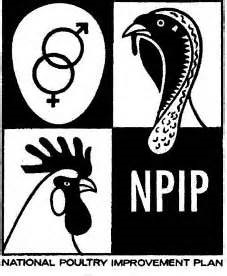
While working along at getting set up to mail chicks for the first time in the fall of 2017 and winter of 2018, a part of that process was to become NPIP and AI certified. Maybe you are mystified, as I was, as to why this is important, and how it is accomplished. If so, read on!
What Is NPIP? And AI Clean?
First, then, what do NPIP and AI stand for? Reputable breeders of chicks should be National Poultry Improvement Plan certified and Avian Influenza clean, and must do so to legally transport birds across state lines. Here is a brief explanation of the history and purpose of the National Poultry Improvement Plan (NPIP) from their website.
The National Poultry Improvement Plan was established in the early 1930’s to provide a cooperative industry, state, and federal program through which new diagnostic technology can be effectively applied to the improvement of poultry and poultry products throughout the country. The development of the NPIP was initiated to eliminate Pullorum Disease caused by Salmonella pullorum which was rampant in poultry and could cause upwards of 80% mortality in baby poultry. The program was later extended and refined to include testing and monitoring for Salmonella typhoid, Salmonella enteritidis, Mycoplasma gallisepticum, Mycoplasma synoviae, Mycoplasma meleagridis, and Avian Influenza. In addition, the NPIP currently includes commercial poultry, turkeys, waterfowl, exhibition poultry, backyard poultry, and game birds. The technical and management provisions of the NPIP have been developed jointly by Industry members and State and Federal officials. These criteria have established standards for the evaluation of poultry with respect to freedom from NPIP diseases.
APHIS’ mission is to safeguard the health of our nation’s agricultural resources. Our many animal health experts work closely with other federal agencies, states, foreign governments, industry and professional groups, and others to enhance international trade and cooperation while preventing the introduction of dangerous and costly pests and diseases.
 Chicks and hatching eggs that carry these avian diseases can threaten not only flocks to whom they come, but humans as well. Responsible farmers who sell chicks seek to make sure that the birds they mail are healthy. So, what is the process in becoming certified NPIP and AI clean?
Chicks and hatching eggs that carry these avian diseases can threaten not only flocks to whom they come, but humans as well. Responsible farmers who sell chicks seek to make sure that the birds they mail are healthy. So, what is the process in becoming certified NPIP and AI clean?
The program is administered through state agricultural extension offices. You can find out contact information for your official state officer by clicking here. In my state, West Virginia, inspectors come to your farm for free. (Yeah, it’s almost heaven here for sure!) In many other states, there will be a fee.
So, What’s the Process?
I started the process by sending an email query to the contact listed on the NPIP page linked above. I had to wait about five days for a response, but it was June and I assume the contact was on vacation, because when I did get an email it was very helpful and detailed. It included a phone number, so I called with a few questions. She took my contact information and told me that the inspector would call shortly to make an appointment. He did so two days later.
My inspector made an appointment with me for two weeks after his call. He came an hour late, but this was fine. He only was interested in testing adult birds (six months and older) who were breeders for the chicks we planned to mail out. (In other words, he didn’t test our laying flock.) We have our birds separated into various outbuildings on our farm. He only wanted to test the ones in our breeding coops. We had six birds for him to test by this criteria, even though we have a laying flock of 20 chickens, and over 85 birds under the age of 6 months.
I was surprised when he told us that most flocks he tests in backyards average 12 birds! He also said that it was fine for him to “test sample” because if any birds were sick, all were, and so testing a sample flock would cover all our birds.
The testing consisted of a wing prick for blood (the Salmonella typhoid test, which gives results instantaneously) , and a mouth swab for Avian Influenza (which gets sent to a lab and we get our results back in two to three weeks). The inspector also looked around our facility and rated it. He rated us an “A” for cleanliness — which he mentioned mostly included no dirt piles around the coops — I think because of rodent infestation, but that’s a guess.
He asked about whether we used automated watering or hand watering. We do the latter: I can’t bring myself to trust automated systems, in case they fail, so we water and feed morning and evenings daily, as well as shutting coop doors by hand. He gave us a “1” for not having automated watering. He did not look into our coops to see the cleanliness levels.
He left us some paperwork to fill in. It’s mostly contact information and the type of operation you are running. Two pages; very simple. We mailed it in, and are waiting for our “all clear.” Our inspector told us that it was on us to call and arrange a repeat visit yearly. It took about a month for us to receive our NPIP #253 from the WVDA.
And that was it! I was glad to clear this hoop and find that my birds are as healthy as I thought they were! I think that, for most of us, if you habitually follow best practices for your birds, you too will clear this hurtle easily, so don’t be afraid to try!